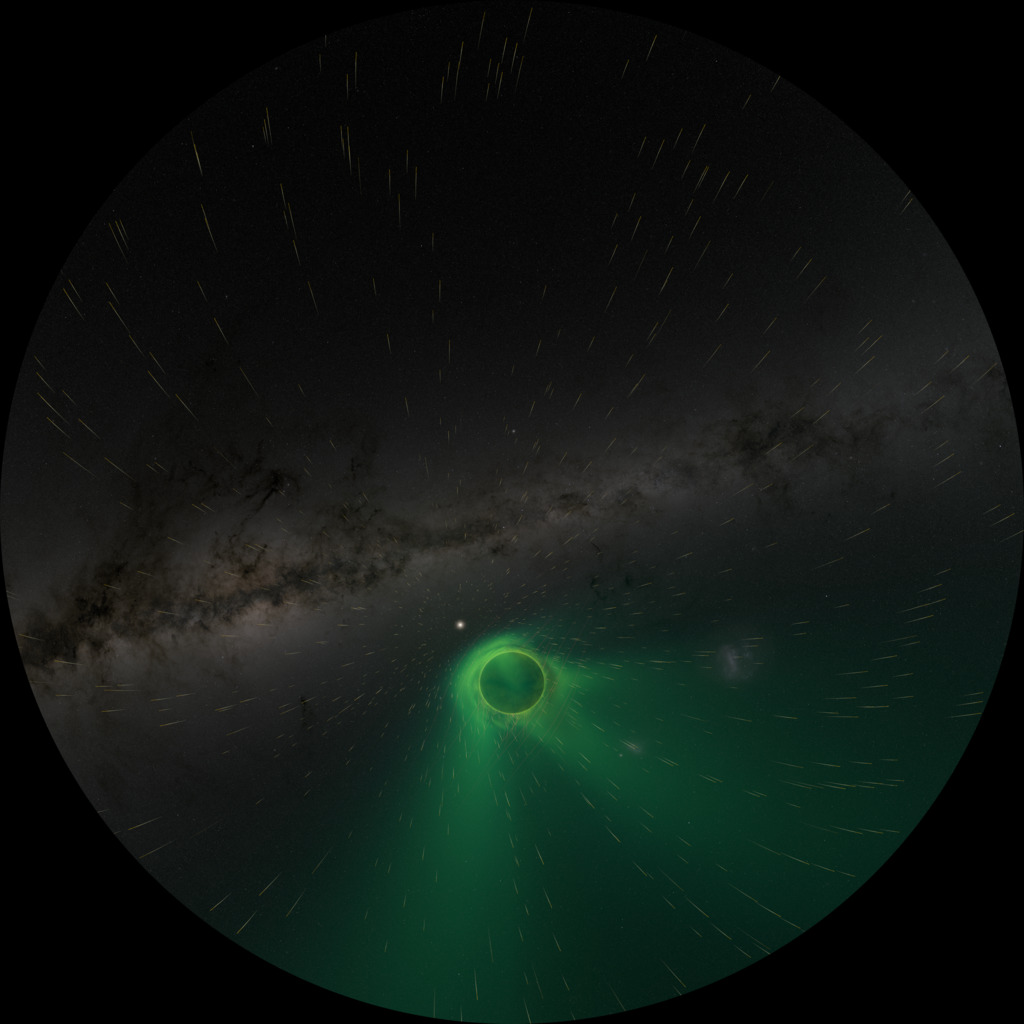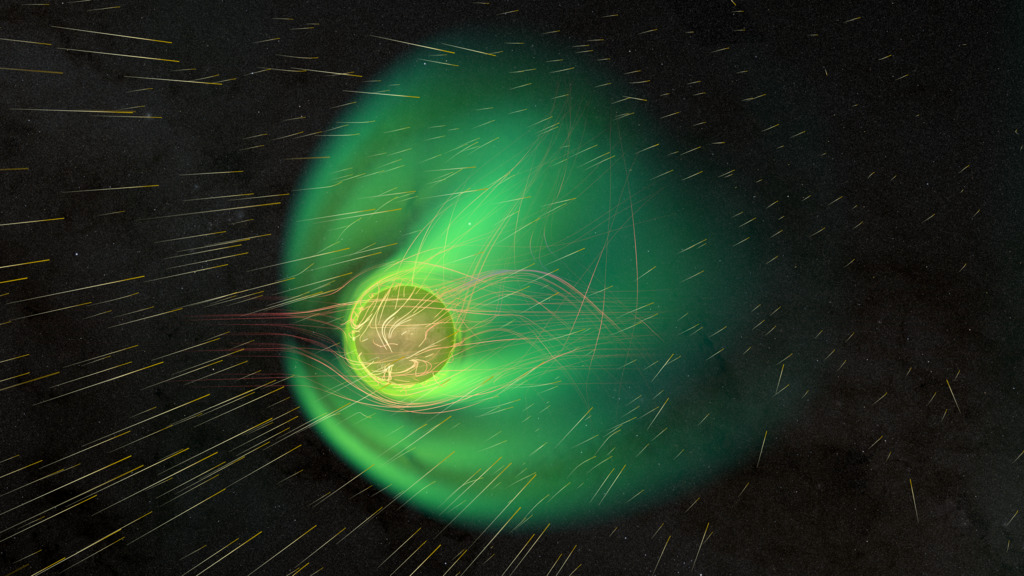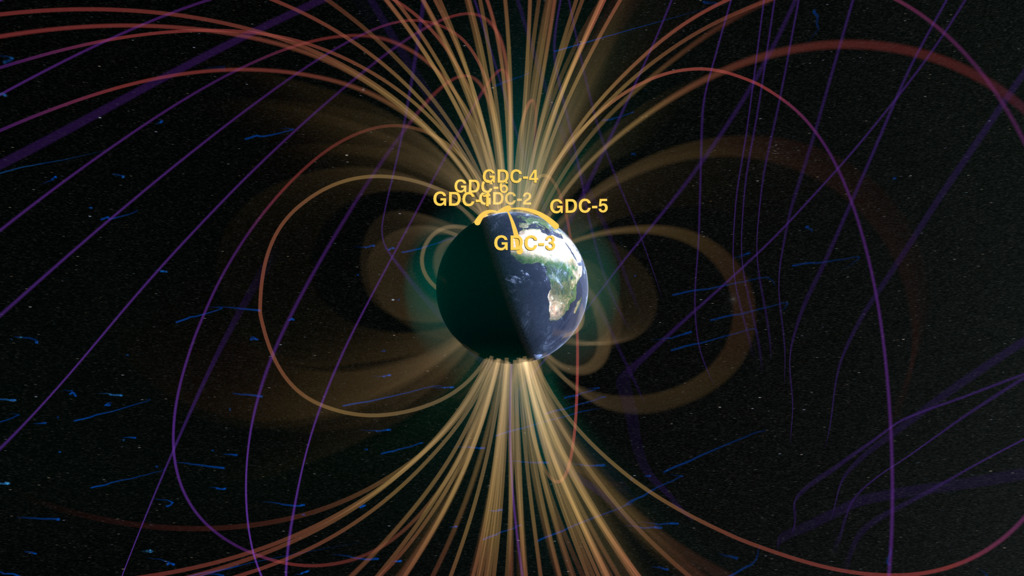Geomagnetic Storm Causes Satellite Loss
In February 2022, a Coronal Mass Ejection led to 38 commercial satellites being lost. Solar plasma from a geomagnetic storm heated the atmosphere, causing denser gases to expand into the satellites’ orbit, which increased atmospheric drag on the satellites and caused them to de-orbit. Johns Hopkins APL-led Center for Geospace Storms (CGS) is building a Multiscale Atmosphere-Geospace Environment (MAGE) supercomputer model to predict space weather. The physics-based MAGE simulation reproduced the storm-time atmospheric density enhancement much better than empirical or standalone ionosphere-thermosphere models, emphasizing the need for fully-coupled whole-of-geospace models for predicting space weather events.
This animation demonstrates the Earth’s magnetosphere being hit by a geomagnetic storm on February 3, 2020, simulated by MAGE during the storm that caused the loss of commercial satellites.
The green current density shows where magnetic current is strong. Lines tracing out the magnetic field are purple in regions of weaker magnetism, and orange-yellow where the magnetic field is strongest. Blue tracers in the velocity field represent the solar wind, and they have been calibrated to appear brightest when they are moving toward the Earth.
Credit:
NASA Scientific Visualization Studio and NASA DRIVE Science Center for Geospace Storms
This animation is the same as above, but has been modified at the beginning to show all Earth-orbiting satellites that were active at the time of the storm. Some of these satellites were adversely affected by the storm.
Credit:
NASA Scientific Visualization Studio and NASA DRIVE Science Center for Geospace Storms
Credits
Please give credit for this item to:
NASA's Scientific Visualization Studio and NASA DRIVE Science Center for Geospace Storms
-
Visualizers
- Andrew J Christensen (SSAI)
- Tom Bridgman (Global Science and Technology, Inc.)
-
Technical support
- Laurence Schuler (ADNET Systems, Inc.)
- Ian Jones (ADNET Systems, Inc.)
-
Scientists
- Slava Merkin (Johns Hopkins University/APL)
- Eric L. Winter (Johns Hopkins University/APL)
Release date
This page was originally published on Monday, December 11, 2023.
This page was last updated on Sunday, March 16, 2025 at 11:06 PM EDT.
Related papers
Datasets used
-
MAGE (Multiscale Atmosphere-Geospace Environment)
ID: 1200MAGE will span the domains of geospace, from the lower atmosphere to the thermosphere-ionosphere, to the different regions of the magnetosphere. It will resolve global dynamics and critical mesoscale processes throughout geospace with highly precise numerical techniques. MAGE will be made available for community use via a permissive open-source license.
This dataset can be found at: https://cgs.jhuapl.edu/Models/mage.php
See all pages that use this dataset -
GAMERA (Grid Agnostic MHD for Extended Research Applications)
ID: 1201GAMERA is a new magnetohydrodynamic (MHD) simulation tool building and improving upon the high-heritage Lyon-Fedder-Mobarry (LFM) code. GAMERA has been written completely from scratch in modern Fortran and provides a flexible, portable, and exascale-capable MHD code. GAMERA features multiple improvements over LFM including: minimal external library dependence, high degree of optimization, OpenMP parallelism allowing use of heterogeneous architectures, and multiple numerics upgrades. Thus, while preserving all key numerical algorithms underlying the LFM code, GAMERA provides a robust and user-friendly solution for sustainable future.
Credit: References
This dataset can be found at: https://cgs.jhuapl.edu/Models/gamera.php
See all pages that use this dataset
Note: While we identify the data sets used on this page, we do not store any further details, nor the data sets themselves on our site.



![Watch this video on the NASA Goddard YouTube channel.Complete transcript available.Music credit: "Breakthrough Discovery" by Phillip John Gregory [PRS] from Universal Production Music](/vis/a010000/a014700/a014739/Thumbnail01.jpg)
![Discovering Earth's Third Global Energy FieldWatch this video on the NASA Goddard YouTube channel.Complete transcript available.Music credit: "Atoms in Motion" by Phillip John Gregory [PRS], “Curious By Nature” by Eddie Saffron [PRS], “Perfect Vibes” by Thomas Gallicani [SACEM], “Natural Response” by Jonathan Elisa [ASCAP] and Sarah Trevino [ASCAP] from Universal Production MusicSound effects: Pixabay](/vis/a010000/a014600/a014628/Thumbnail02.jpg)